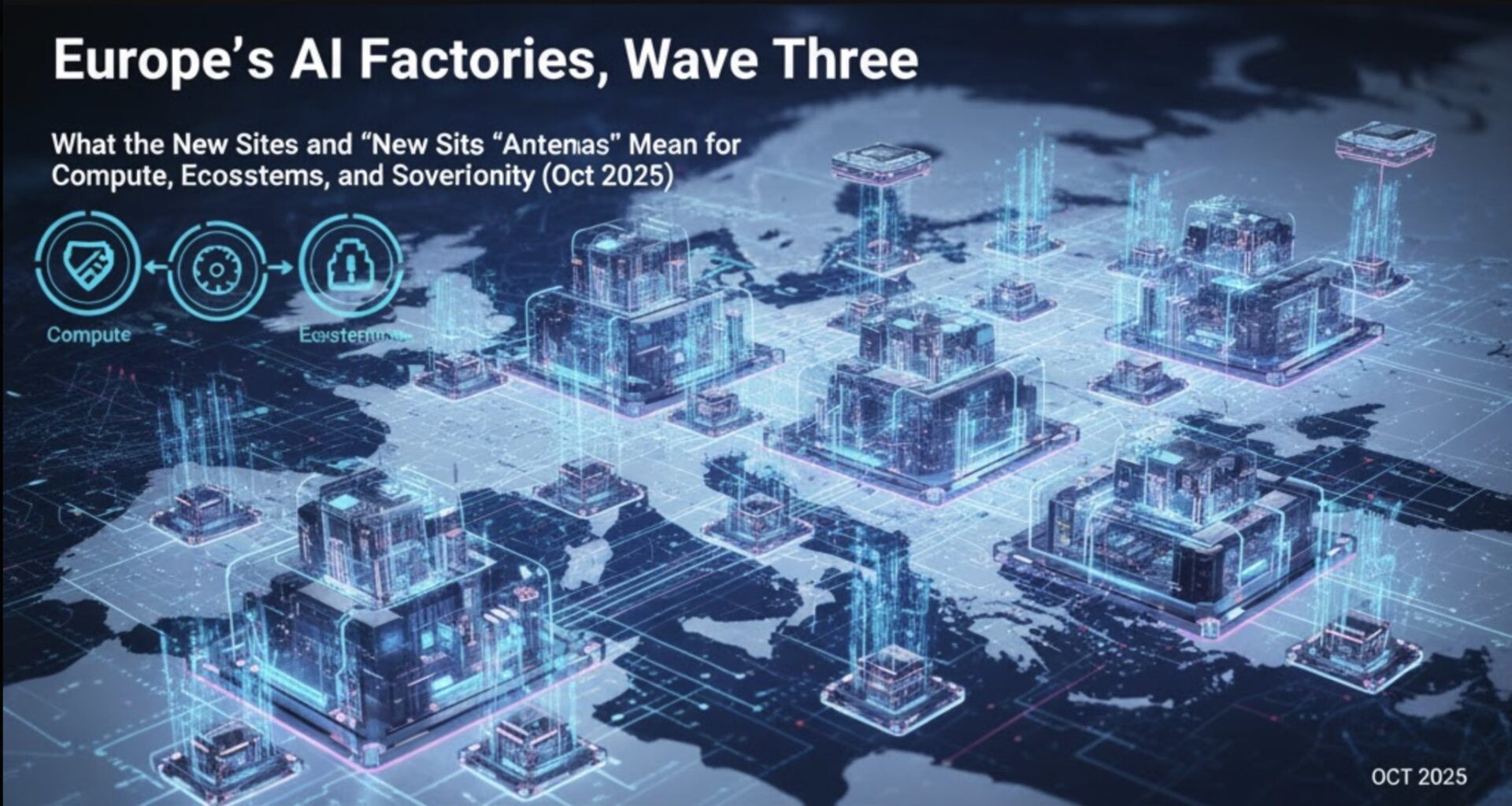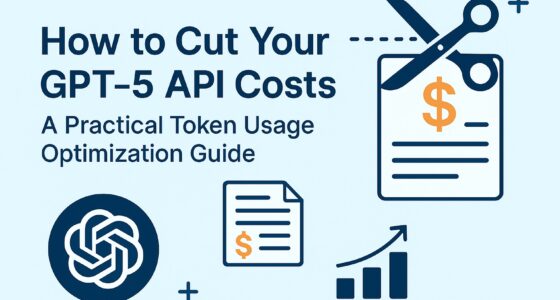Executive summary
On 10 Oct 2025, the EuroHPC Joint Undertaking (EuroHPC JU) selected six additional AI Factories—in Czechia, Lithuania, the Netherlands, Poland, Romania, and Spain—expanding the network’s footprint to nineteen sites since the initiative launched in Dec 2024. Three days later (13 Oct 2025), EuroHPC added 13 “AI Factory Antennas” to broaden reach and on-ramp local users to AI-optimized supercomputing resources. Together, these moves signal a decisive scaling phase for Europe’s applied AI infrastructure—pairing regional access and training with centralized, GPU-dense compute for R&D and startups. eurohpc-ju.europa.eu+1
1) What EuroHPC’s AI Factories are (and aren’t)
EuroHPC’s AI Factories are one-stop hubs bundling AI-optimized compute (often adjacent to national or EuroHPC supercomputers), data facilities, expertise centers, training, and SME/startup support. The initiative launched with seven sites (Dec 2024), expanded by six (Mar 2025), and now adds a third wave of six. The new Antennas are lighter-weight nodes—regional outreach gateways that connect local ecosystems to the nearest Factory’s infrastructure and programs. eurohpc-ju.europa.eu+2BDV Big Data Value Association+2
Why this matters: Europe is building a federated AI compute fabric: big iron where it’s efficient to host it, paired with local access points and capability-building so that researchers, public bodies, and SMEs can actually use the hardware.
2) The Oct 10 selection: six new AI Factories
EuroHPC named Czechia, Lithuania, Netherlands, Poland, Romania, and Spain for the 2025 tranche. The official release emphasizes AI-optimized systems, ecosystem support, and deployment beginning next year. Technical specifics (accelerator counts, MW draw, network topologies) are not yet disclosed publicly. eurohpc-ju.europa.eu
Country snapshots (what’s known today)
- Netherlands (Groningen) — The most detailed case so far. EuroHPC contribution of €70M toward an AI Factory in Groningen, complemented by national and regional co-funding. The project budget is roughly €200M, with operations staged through 2026–2027 (expertise center first; full supercomputing service later). The site is associated with the former Niemeyer factory area and is framed as a national capability hub for startups, science, and education. AI Coalitie 4 NL+3surf.nl+3Techzine Global+3
- Spain — The new Spanish Factory will include an experimental platform for testing models and applications—positioning Spain as a European testbed for cutting-edge techniques. Details on power, system scale, and timeline remain pending. Anadolu Ajansı
- Czechia, Lithuania, Poland, Romania — Formally selected; public technical details and commissioning schedules have not been published at this writing. (Czechia is expected to align with existing national HPC assets, but specifics are not in the EuroHPC release.) eurohpc-ju.europa.eu
Context: Earlier waves landed sites in Finland, Germany, Greece, Italy, Luxembourg, Spain, Sweden (Dec 2024), then Austria, Bulgaria, France, Germany, Poland, Slovenia (Mar 2025). The third wave deepens coverage in Central/Eastern and Southern Europe while bolstering Benelux. eurohpc-ju.europa.eu+1
3) The Oct 13 “AI Factory Antennas”: widening the funnel
EuroHPC simultaneously announced 13 Antennas—a network of outreach and enablement nodes that expand access to Factory services (training, support, remote compute access) beyond host cities and into additional Member States and partner countries. EU funding is ~€55M (matched nationally). The European Commission highlighted Antenna awards spanning Belgium, Cyprus, Hungary, Ireland, Latvia, Malta, Slovakia and partner countries including Iceland, Moldova, Switzerland, the UK, North Macedonia, and Serbia. National governments (e.g., Ireland) have issued aligned statements underscoring the role of Antennas as stepping-stones toward bigger HPC/AI bids. eurohpc-ju.europa.eu+2Digital Strategy EU+2
What Antennas solve:
- Reduce distance-to-compute and bureaucracy for SMEs and research labs.
- Provide training, datasets, MLOps best practices, and application onboarding.
- Backhaul traffic to nearby Factories where the AI-dense nodes actually run.
4) Strategic significance
4.1 Compute sovereignty meets ecosystem activation
By federating large AI systems with local on-ramps, Europe addresses two chronic bottlenecks: scarce accelerator access and capability diffusion outside major metros. The Dutch case, with €200M total budget and €70M from EuroHPC, epitomizes tripartite funding (EU, national, regional) and governance built around public values (privacy/ethics) and sector use cases (healthcare, energy, agriculture, security). Techzine Global+2AI Coalitie 4 NL+2
4.2 Complementarity with “AI gigafactories”
In parallel, the Commission has floated AI gigafactories—much larger compute hubs—with dozens of proposals noted mid-2025. The AI Factory network is complementary and nearer-term, focused on accessibility and services; gigafactories target mass-scale training/inference capacity. Expect coordinated roadmaps and potential vendor overlaps (GPUs, networking, power/cooling). Reuters
5) Timelines and what to watch (2025–2027)
- 2025–2026: Procurement/design, site prep, and staged service rollouts (training, data, remote access) begin; Antennas become active as outreach centers. (EuroHPC indicates deployment “next year” for new sites.) eurohpc-ju.europa.eu
- 2026–2027: Several Factories, notably Groningen (NL), plan to move from expertise/data services to full supercomputing operations by 2027. surf.nl+1
- Spec disclosures: Watch for public tenders revealing GPU generation, node counts, interconnects, storage tiers, and MW draw. (As of mid-Oct 2025, these details are mostly undisclosed in official communications.) eurohpc-ju.europa.eu
6) Risks and constraints
- Supply chain & vendor lock-in: Even with EU funding, deliveries of leading-edge accelerators and optics can slip; Europe will need multi-vendor strategies and long-term framework contracts.
- Power & cooling: AI clusters push dense, continuous loads; grid interconnects, heat reuse, and liquid cooling retrofits will determine siting success. (Several sites are repurposing industrial facilities—e.g., Groningen—which can help.) University of Groningen
- Talent throughput: Antennas can mitigate, but large clusters require sustained DevOps/MLOps/SRE pipelines and domain scientists.
- Utilization & ROI: Factories must avoid under-use; onboarding pipelines, voucher programs, and sector accelerators are key to keep GPUs hot.
7) Implications for startups, researchers, and public bodies
Startups/SMEs
- Near-term: Engage Antennas for training, credits/vouchers, and remote access pathways; prepare compliance (data governance, security) to qualify quickly. eurohpc-ju.europa.eu
- Medium-term: Co-develop reference applications with Factory teams (healthcare diagnostics, industrial quality, energy optimization). Leverage pan-EU access to specialized datasets and HPC schedulers.
Universities/Research labs
- Align proposals with Factory priority domains (e.g., health, climate, language tech). Expect joint PhD/industry chairs and shared staffing models as Factories scale. University of Groningen
Public sector
- Use Factories for sovereign AI pilots (translation, citizen services, fraud detection) under EU-aligned privacy/ethics frameworks; Antennas provide local facilitation and procurement support. eurohpc-ju.europa.eu
8) Country focus: the Netherlands (Groningen)
- Funding mix: ~€200M total; €70M EuroHPC, €70M national, €60M regional (Groningen/North Drenthe). Techzine Global
- Location & concept: Former Niemeyer industrial site; three pillars—expertise center, data facility, supercomputer. University of Groningen
- Use-case alignment: Health, agriculture, energy, security; strong emphasis on responsible AI and public values. ICT&health Global
- Milestones: EU funding confirmation (Oct 2025); staged opening from 2026, moving to full compute by 2027. surf.nl
9) How this dovetails with prior waves
The third-wave selections fill geographic gaps while reinforcing earlier hubs in Nordics, DACH, Mediterranean, and CEE. Spain’s additional Factory (with an experimental platform) suggests differentiated roles—some sites as training/testbeds, others as heavy compute anchors—within a federated architecture. Anadolu Ajansı
10) Action checklist (practical next steps)
- Identify your nearest Antenna and Factory: join their mailing lists, attend onboarding sessions, and pre-register your project needs (GPU profile, data locality, security requirements). eurohpc-ju.europa.eu
- Compliance-ready data: Inventory datasets; prepare DPIAs, data sharing agreements, and model cards so you can move fast once access opens.
- Right-size your workloads: Plan for hybrid runs (prototype on smaller nodes via Antennas; scale on Factory clusters).
- Co-funding & vouchers: Track EU/national instruments tied to Antennas/Factories—credits, training grants, and SME innovation vouchers. eurohpc-ju.europa.eu
- Talent pipeline: Partner with local universities and Factory training teams to source MLOps/SRE talent ahead of the 2026–2027 ramp. University of Groningen
11) Outlook
Between new Factories and Antennas, Europe is moving from announcements to activation. The Netherlands case provides a template: multi-level funding, adaptive reuse of industrial real estate, and explicit sector missions. Expect 2026 to be the year of procurement and pilot ramp, with meaningful, production-grade capacity arriving into 2027—and a growing interplay with any forthcoming AI gigafactories. surf.nl+1









